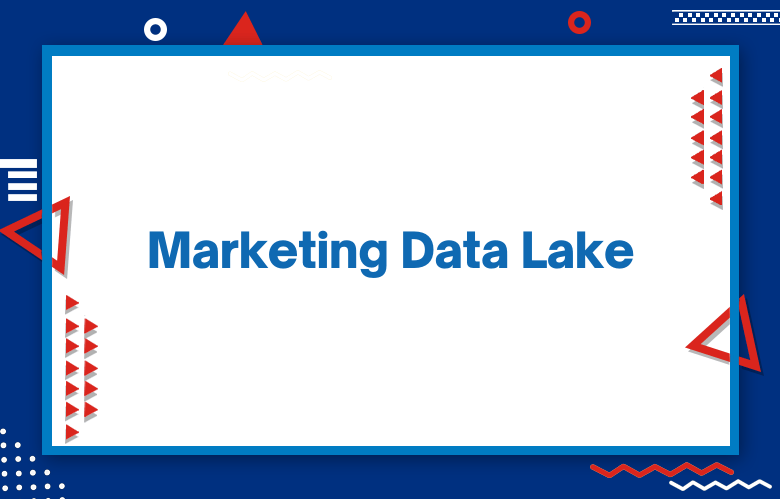Marketing Data Lake: How Data Lakes Support Data-Driven Marketing

Marketing data lakes are a relatively new addition to the marketing landscape. They facilitate data-driven campaigns and analytics by storing vast amounts of raw and processed data, which can be mined for insights in near real-time.
The data-driven marketing era is here. And with it, a modern approach to storing and managing data throughout its entire lifecycle is needed. Data lakes offer an enterprise-wide solution that can be tailored to meet each organization’s specific needs, from acquisition through storage, management, and data analysis.
The concept of “data-driven marketing” is nothing new: organizations have been leveraging analytics tools like Google Analytics, Optimizely, Facebook Ads Manager, etc., for years to make smarter business decisions and allocate their resources more efficiently based on what they know about their customers rather than just guessing.
Organizations are increasingly turning to data-driven marketing strategies. They need a scalable, adaptable, and secure platform to handle the demand for more data and greater analytic sophistication. Data Lakes meet these needs by providing powerful analytics tools to enable organizations to make better decisions faster.
What is a Data Lake?
A Data Lake is a storage repository used for extensive data analysis. It’s a massive and scalable collection of data stored in its native format called NoSQL, which stands for “Not Only SQL.”
A Data Lake is a storage builder where big data can be stored in an unfettered format.
A data lake is an extensive repository of your company’s data. It’s ideal for storing any unstructured information and making it easily accessible to different types of tools.
A data lake is a process to store all of your organization’s raw and big unprocessed data, including structured and unstructured information.
A data lake storage container holds structured, semi-structured, and unstructured data. It’s designed to retain all data types, even when actively used for analytics or reporting purposes.
What is a Marketing Data Lake?
A Marketing Data Lake is a big store that stores all of your customer data. Getting insights from centralized data is easier and cheaper than storing everything elsewhere.
A marketing data lake is a collection of raw customer data.
A Marketing Data Lake is a place to store all the data generated by website visitors and other interactions. It’s like having one big bucket of water to dip your cup whenever you need information.
A data lake is an extensive collection of all your data from your customers, suppliers, and partners. It’s called a “lake” because it can store as much information as an actual lake.
A data lake is an inexpensive, single-source repository that stores all the raw unstructured and structured data collected from different sources. It’s easy to query this store because it uses a non-proprietary file format like Apache Parquet.
What is a Customer Data Lake?
A Customer Data Lake is a central repository of structured and unstructured customer data. It’s an accessible source of information that can be continuously analyzed to uncover new insights and drive more relevant customer experiences.
A customer data lake is a storage system that collects and stores all your company’s customer information.
A Customer Data Lake is a client-side system of record for customers and prospects.
A Customer Data Lake is a data storage system that can be accessed by multiple teams and used to create a customer profile. A Customer Data Lake provides an overview of the customer experience, allowing you to make better customer decisions at every point.
A Customer Data Lake is a single, central location where all customer data lives. This includes much different information on your customers—everything from their contact details to what they’ve purchased and how often they’ve visited your website.
Big Data and The Superior Customer Experience
Marketing Data Lake: Turn Raw Data into Predictive Insights and Analytics
How Data Lakes Support Data-Driven Marketing
Data lakes are an essential component of a data-driven marketing strategy.
Business intelligence is essential to any company. It helps drive growth for companies and streamlines tasks for workers.
Big data is the future of marketing. It’s a must for businesses to stay competitive, and it can make or break them.
A data lake is a repository designed for storing all sorts of datasets. You can put log files and customer records in this place and analyze them later. It’s ideal for supporting marketing because it contains so many different types of data.
Enterprise data lake architecture for marketing analytics
The Big Data market is booming, and companies are always looking to improve their data analytics. One business source recommends using an enterprise data lake architecture to get ahead of the competition.
A data lake storage container stores all enterprise data in its native format. With a data lake, the organization can access any data without reformating it first instead of just one or two centralized databases and tools.
A data lake is an alternative to a traditional database that stores raw structured and unstructured data in its native format. Data lakes are usually used for big-data analytics, where the goal is to gain insight from massive amounts of semi-structured.
One of the significant factors of marketing analytics is having a data lake architecture that can process vast amounts of information. This allows you to determine which campaigns work best and for what audiences.
How Data Lakes Support Data-Driven Marketing
A data lake is a storage builder for raw, structured, unprocessed, and semi-structured data in its native format. It typically holds the entire enterprise data inventory used by all other business applications.
Data lakes are a way to store big data. As organizations expand the scope of their marketing initiatives, they need more data available for analysis. Data lakes help companies centralize data storage and access.
At a high level, data lakes are a way to store all your analytics and reports. You can review the data anytime and see how everything is doing.
Data-driven marketing is the future of business, but it’s not easy. Many obstacles along the way include data silos and poor analytics. Learn more about how big data can help your company succeed here:
Account-Based Marketing and the Data Lake
The data lake is a process that allows you to access and use any form of data. Account-Based Marketing uses the data lake to know who you target in your campaign, why they should be targeted, and how to communicate with them.
As ABM moves to the next level, marketers use a Data Lake approach to manage and analyze marketing data.
Account-Based Marketing (or ABM) is a way of targeting accounts with marketing campaigns. It usually involves automated data collection and using the Data Lake to create personalized content. The primary benefit of this process is that it saves costs.
Understanding how an ABM approach can help you build a comprehensive customer data lake is essential.
It’s a well-known fact that account-based marketing (ABM) has grown in popularity over the last few years, but this growth could be due to two key pillars: lead scoring and analytics.
Management of Metadata in the Marketing Data Lake
Did you know that Metadata is essential? It’s what helps to describe your company, products, and services. It can produce reports and add context for metadata management in the Marketing Data Lake.
Metadata is a tricky thing because it’s hard to manage. The Metadata in your marketing data lake typically consists of several parts: the data itself, its schema, and some documentation.
- Data Drives Innovation
- Deep segmentation
- Marketing attribution
- Social sentiment analysis
- B2B targeting
How to Harnessing The Full Potential Of Data Lakes
The primary purpose of a data lake is to store raw data in its native format, preferably indefinitely. There are many reasons to keep your data around for as long as possible.
The first step is to ensure you have the right team. It helps if you have a data engineer, a data scientist, and an analyst.
Data lakes have become increasingly common throughout the data analytics industry, but few companies are getting much out of them.
To harness the full potential of data lakes, you need to take a few steps. First, make sure you have an accurate classifier for your data lake.
Cultivate a Big Data-Driven Approach to Marketing
Garbage In, Garbage Out (GIGO)
Best Practices for a Marketing Data Lake
- Start with your business goals
- Determine the data sources that will be needed to achieve those goals
- Decide how much data you can afford to store and process
- Choose a storage medium for your data lakes, like Hadoop or Amazon S3
- Map out all of the different types of files that need to be stored to meet these requirements
- Determine what data you want to keep
- Consider a variety of storage options and choose one that suits your needs
- Choose the right analytics tools for your business, such as SQL R, or Python
- Build an environment where anyone can access data easily with the necessary permissions
- Create a data lake team to manage the project
- Ensure you have the right people to ensure your data is secure and accessible.
- Define what information needs to be collected, where it will be stored, and how it will be used.
- Map out different data sources that can feed into your marketing data lake.
- Get buy-in from stakeholders on all levels for this project
- Develop a data governance strategy
- Create an enterprise-wide metadata registry
- Implement the right tools and procedures for managing your data lake’s contents.
- Ensure that all new content is stored in the data lake, not just current assets
- Ensure you understand what information must be stored in the data lake before implementing it.
- Choose a data management platform.
- Determine your organization’s needs and goals for the Data Lake
- Create a map of all existing data sources in your organization
- Prioritize which datasets will be stored in the Data Lake based on their use, frequency of use, value, and size
- Define how to collect new data from internal systems that are not currently connected to the Data Lake but should be added at some point in time (e.g., CRM)
Conclusion
Data lakes are the key to unlocking data-driven marketing success. A data lake is an on-premise raw, unstructured, and structured data repository.
It can be used by marketers in many different ways, from creating a customer profile of individual customers to analyzing their behavior over time or segmenting products based on what they look like online.
The possibilities are endless when you have access to this wealth of information about your business and its consumers. If you’re ready to take your marketing strategy up a notch with significant insights into how people interact with your brand, get in touch today!
Call: +91 9848321284
Email: [email protected]



